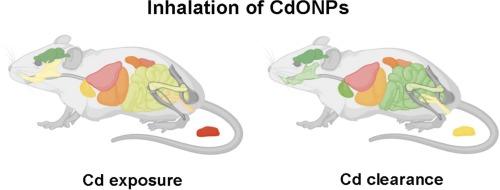吸入氧化镉纳米颗粒后,次级靶器官表现出不同的清除镉的能力
IF 11.3
1区 环境科学与生态学
Q1 ENGINEERING, ENVIRONMENTAL
引用次数: 0
摘要
吸入的氧化镉纳米颗粒(CdONPs)由于其潜在的全身生物蓄积和器官特异性毒性,是一种未被充分认识的环境和职业危害。在这项研究中,小鼠暴露于亚慢性吸入CdONPs,并通过原子吸收光谱法、激光消融电感耦合等离子体质谱法、组织病理学和基因表达分析,在21天的恢复期评估镉的分布、清除和组织反应。镉主要积聚在肺部,清除缓慢,并伴有持续的炎症和泡沫细胞形成。肠道表现出有效的镉还原,可能是由于上皮细胞的高更新,而肝脏表现出最小的积累,没有明显的损伤。相比之下,肾脏主要在皮质中保留镉,并伴有部分清除和超微结构改变,包括线粒体解体和脂质积累。骨组织表现出不同程度的保留:颌骨有效地清除了镉,而股骨则表现出持续或增加的水平,表明镉来自其他器官。基因表达分析显示,清除组肾脏中Abca1、Apoe和Ptch1的表达适度但一致上调,表明脂质代谢和膜转运方面的适应。这些发现强调了吸入CdONPs的器官特异性清除动力学和分子反应,强调了纳米颗粒毒理学中组织靶向风险评估框架的必要性。本文章由计算机程序翻译,如有差异,请以英文原文为准。

Secondary target organs exhibit differential ability to clear cadmium after cadmium oxide nanoparticle inhalation
Inhaled cadmium oxide nanoparticles (CdONPs) represent an underrecognized environmental and occupational hazard because of their potential for systemic bioaccumulation and organ-specific toxicity. In this study, mice were exposed to subchronic inhalation of CdONPs, and cadmium distribution, clearance, and tissue responses were assessed over a 21-day recovery period using atomic absorption spectrometry, laser ablation inductively coupled plasma mass spectrometry, histopathology, and gene expression analysis. Cadmium accumulated predominantly in the lungs, where clearance was slow and accompanied by persistent inflammation and foam cell formation. The intestines exhibited efficient cadmium reduction, likely due to high epithelial turnover, while the liver showed minimal accumulation and no overt damage. By contrast, the kidneys retained cadmium primarily in the cortex, with partial clearance and ultrastructural changes, including mitochondrial disorganization and lipid accumulation. Bone tissues demonstrated differential retention: jaw bones effectively cleared cadmium, whereas femurs showed sustained or increased levels, suggesting redistribution from other organs. Gene expression analysis revealed moderate but consistent upregulation of Abca1, Apoe, and Ptch1 in the kidneys of clearance groups, indicating adaptations in lipid metabolism and membrane transport. These findings highlight organ-specific clearance kinetics and molecular responses to inhaled CdONPs, underscoring the need for tissue-targeted risk assessment frameworks in nanoparticle toxicology.
求助全文
通过发布文献求助,成功后即可免费获取论文全文。
去求助
来源期刊

Journal of Hazardous Materials
工程技术-工程:环境
CiteScore
25.40
自引率
5.90%
发文量
3059
审稿时长
58 days
期刊介绍:
The Journal of Hazardous Materials serves as a global platform for promoting cutting-edge research in the field of Environmental Science and Engineering. Our publication features a wide range of articles, including full-length research papers, review articles, and perspectives, with the aim of enhancing our understanding of the dangers and risks associated with various materials concerning public health and the environment. It is important to note that the term "environmental contaminants" refers specifically to substances that pose hazardous effects through contamination, while excluding those that do not have such impacts on the environment or human health. Moreover, we emphasize the distinction between wastes and hazardous materials in order to provide further clarity on the scope of the journal. We have a keen interest in exploring specific compounds and microbial agents that have adverse effects on the environment.
 求助内容:
求助内容: 应助结果提醒方式:
应助结果提醒方式:


